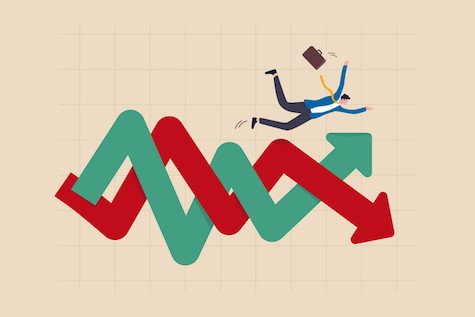How and why investment markets have performed the way they have this year.

.
A single day can be a long time on financial markets.
Take Wednesday 6 December for example, when the Australian share market (measured by the S&P/ASX 300 Index) surged by 1.65% — the biggest daily gain in more than a year of trading.
The reason behind the surge? Expectations that the Reserve Bank of Australia will begin cutting interest rates late next year (which followed the RBA’s decision to keep rates on hold at 4.35% at its December meeting) triggered a rally in bank and real estate stocks, two sectors that are particularly sensitive to movements in rates.
But a day later the market lost ground, with the share prices of many energy companies falling after a plunge in the oil price amid concerns of a looming supply glut.
Energy price shocks, surging inflation, rising interest rates, recession fears, geopolitical tensions and a host of other factors have fuelled ongoing turbulence on investment markets throughout 2023.
Yet despite this, most share markets have recorded gains since the start of the year. At the same time, successive rises in interest rates have resulted in huge cash inflows into fixed income securities from investors seeking higher income returns.
Australia’s exchange traded funds sector has continued to build momentum over 2023, with the value of ETF assets under management having grown by over $35 billion to a record $165 billion by the end of November.
The market index returns to date quoted below cover the trading period from 3 January 2023 to 13 December 2023.
Broad share market gains
Share market investors have experienced heightened daily volatility throughout this year, but some markets have recorded strong gains on a year-to-date basis.
The broad United States share market, when measured by the S&P 500 Index, has gained over 21%, largely driven by strong price rallies in big technology stocks. The technology-centric Nasdaq Composite Index has soared close to 40%.
Thus, investors with broad exposure to U.S. shares through index-tracking exchange traded funds (ETFs) have recorded strong double-digit returns since the start of 2023.
Another strong share markets performer has been Japan, also on the back of gains by technology stocks, with its benchmark Nikkei 225 Index having risen around 28% since the start of the year. The Indian share market, measured by the Nifty 50, has risen about 15%.
By contrast, the Australian share market (measured by the S&P/ASX 300 Index) has not performed as strongly. On a year-to-date basis, while in positive territory, it has only gained about 4%. This reflects a combination of factors including investor sentiment over interest rates and movements in commodity prices.
Nevertheless, investor inflows into the Australian equities segment of the ETFs market have surged, reflecting an increase in investors’ confidence about share market returns over the longer term.
The pause in the interest rate hiking cycle has been another driver acting as a tailwind for Australian equities.
The rebound in bonds
Meanwhile, investors have shown renewed interest in fixed income securities (including bonds) throughout this year.
At different points of the year investor inflows into bond ETFs that invest in government bonds with investment grade credit ratings have been higher than the inflows into equities ETFs.
The reason for that has been fairly simple. Although rising interest rates have created pain for borrowers, investors have been able to lock in higher interest rate returns on bonds.
This has led to record inflows into fixed income ETFs around the world, including in Australia.
The investment dynamics in bond markets have been changing in recent weeks however with the prospect that central banks including the RBA will begin cutting interest rates during 2024. Bond market investors have already sent yields tumbling over the past month, to get ahead of the start of rate cuts.
Australian inflation levels remain high however, and so it’s evident that interest rates will need to stay high for an extended period so the RBA can reel back inflation to within its 2%-3% target band.
Diversification remains key
As always, having a diversified portfolio of investments is key because the returns from different asset classes and market segments vary from year to year.
In the 2022-23 financial year the best-performing asset class was United States listed shares, which returned 23.5%. International shares returned 22.6%. The worst-performing assets were international bonds (hedged) and international listed property, which both fell 1.5%. Australian shares gained 14.8%.
But if you compare those results with the previous year, it was a very different story. Cash was the best performer, returning a marginal 0.1%. Australian listed property was the worst performer, falling 12.3%, while international shares (hedged) fell 11.3%.
Making tactical adjustments to a portfolio based on what’s happening on investment markets at any point in time, particularly when there’s a high level of turbulence, may seem logical.
Rather than making tactical changes, investors who stay aligned to their goals, who are well diversified, who minimise their costs, and who have the discipline to stay invested, even during periods of heightened volatility, have the best chance of investment success over the long term.
Important information and general advice warning
Vanguard Investments Australia Ltd (ABN 72 072 881 086 / AFS Licence 227263) is the product issuer of the Vanguard ETFs and the Operator of Vanguard Personal Investor. We have not taken your objectives, financial situation or needs into account when preparing this publication so it may not be applicable to the particular situation you are considering. You should consider your objectives, financial situation or needs, and the disclosure documents for Vanguard ETFs before making any investment decision. Before you make any financial decision regarding Vanguard ETFs , you should seek professional advice from a suitably qualified adviser. A copy of the Target Market Determinations (TMD) for Vanguard's financial products can be obtained at vanguard.com.au free of charge and include a description of who the financial product is appropriate for. You should refer to the TMD for Vanguard ETFs before making any investment decisions. You can access our IDPS Guide, PDSs Prospectus and TMD at vanguard.com.au or by calling 1300 655 101. Past performance information is given for illustrative purposes only and should not be relied upon as, and is not, an indication of future performance. This publication was prepared in good faith and we accept no liability for any errors or omissions.
December 2023
Tony Kaye
vanguard.com.au






















